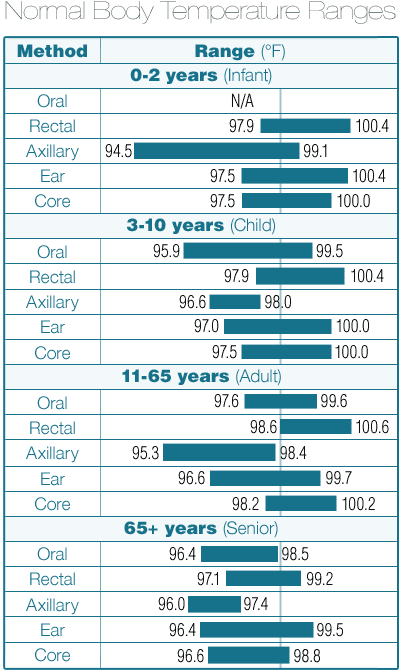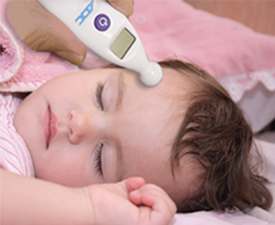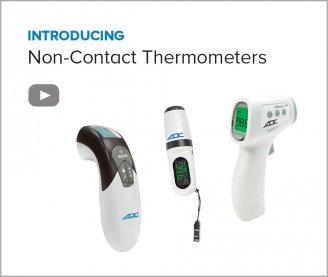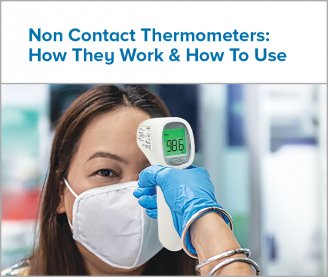- Products
- New Products
- Featured Products
- Color and Print Themes
- Blood Pressure Measurement
- NIBP / Vital Sign Monitors
- Digital Aneroid Sphygmomanometers
- Palm Aneroid Sphygmomanometers
- Pocket Aneroid Sphygmomanometers
- Pro's Combo Sphygmomanometers
- Multicuff Sphygmomanometers
- Clock Aneroid Sphygmomanometers
- Mercury Sphygmomanometers
- Home Blood Pressure Measurement
- Adcuff +
- Gauges
- Bulb & Valves
- Disposable Cuffs
- Reusable Cuffs & Bladders
- Sphygmomanometer Accessories
- Sphygmomanometer Parts
- Caseware
- CPR / Airway
- EENT
- Instruments & Accessories
- Laryngoscopes
- Penlights
- Pulse Oximeters
- Stethoscopes
- Thermometry
- Vital Signs Monitors
- Solutions
- About ADC
- Learning Center
- Support
- Blog
- Contact
How to Take Temperature

Temperature ranges vary by age and by measurement method.
Taking temperature is a relatively simple procedure. But there are a few things you can do to get more accurate readings and, as a result, ensure the best experience from your thermometer.
The first factor to consider when taking a person’s temperature is the measurement site. If you’re using a digital stick thermometer, there are three options: oral, axillary (i.e., underarm), and rectal. The choice of a particular site is typically dependent on the patient’s age and physical condition (more on this below).
The primary goal of taking a measurement is to obtain an estimate of a patient’s core body temperature. But it’s important to know that a reading taken at one of the three sites mentioned above doesn’t actually tell you a person’s core body temperature. Instead, it represents a number you can compare to an average.
Average human temperature is approximately 98.6 °F (though several recent studies have suggested this number has been dropping over the last century). But rectal measurements may read as much as a degree higher, with the average temperature being 99.5 °F. Inversely, axillary measurements tend to be lower, with an average temperature being around 97.7 °F. Even oral measurements tend to be lower than core body temperature, with an average reading being 98.2 °F.
In addition, body temperature varies at different times of day and depending on certain environmental factors. Age also plays a role. The chart included here shows how some of these variables impact temperature ranges.
Oral Measurement
 Oral measurements are by far the most popular. This method is generally recommended for patients four years and older who will not bite down on the probe tip during measurement. The probe tip should be positioned under the patient’s tongue in the sublingual pocket, which is where the back of the tongue and floor of the mouth meet.
Oral measurements are by far the most popular. This method is generally recommended for patients four years and older who will not bite down on the probe tip during measurement. The probe tip should be positioned under the patient’s tongue in the sublingual pocket, which is where the back of the tongue and floor of the mouth meet.
Things to remember:
- Recent eating or drinking very hot or cold food and beverages can affect temperature measurement when measuring orally. Advise patients not to eat or drink anything prior to measurement.
- Recent physical activity can alter a person’s core body temperature. If necessary, give the patient time to recuperate prior to taking a measurement.
- The patient’s mouth should remain closed during the measurement, since cooler air from the environment can affect readings.
- Many digital stick thermometers are designed for use with a probe cover. Covers keep the thermometer sanitary. Consult the instructions for use that accompany your device to determine if probe covers are necessary and what type are recommended.
Rectal Measurement
Rectal measurement is often recommended for babies and toddlers up to three years of age.
Things to remember:
- Water-soluble jelly should be used as a lubricant. This allows for easier insertion of the probe and increases patient comfort during the measurement. Lubricants are generally placed over a probe cover.
- The probe tip should be inserted no more than ½ inches or 1.3 cm into the rectum. Never force the probe tip in if resistance is encountered.
- Recent physical activity, especially involving the legs or lower body, can elevate a rectal measurement. If necessary, give the patient time to recuperate prior to taking the reading.
Axillary Measurement

Axillary, or armpit, measurements are often used for young children or adults whose temperature can’t safely be done orally. The probe tip should be positioned parallel to the body, with the tip pointing towards the patient’s head.
Things to remember:
- The underarm must be dry. If needed, use a towel prior to taking a measurement.
- After placing the probe tip in the armpit, bring the patient’s arm down close against the body to trap body heat.
New Measurement Technologies
New technologies have expanded measurement options and can provide faster, more convenient readings. These include:
- Tympanic thermometers, which measure the temperature of the tympanic membrane in the ear
- Temporal thermometers, which measure the temperature of the temporal artery at the forehead or temple
- Non-contact thermometers, which are a type of temporal thermometers that can measure without making direct skin contact
These types of measurements require specialized thermometers. As with digital stick thermometers, some are designed for use with probe covers. And proper technique remains essential.
When using a tympanic or temporal thermometer, carefully review the instructions for use. Pay particular attention to the proper measurement sites, thermometer positioning, and probe cover use prior to taking a measurement. While these methods provide fast temperature measurement, you’ll have the best results if you observe correct measurement technique.

New technologies, like that used in temporal thermometers, simplify taking temperature measurements on pediatric patients.
As with rectal measurement sites, tympanic thermometers may give slightly higher readings, with the average temperature around 99.5 °F. Temporal measurements are closer to true core body temperature and, provided that the probe has been properly positioned, will give readings that are closer to average body temperatures of 98.6 °F.
For non-contact models, most manufacturers require that their instruments be used at “room” temperature. This is because software calculates the core body temperature equivalent by scanning the forehead and factoring in environmental temperature. For best results, these instruments also require the patient acclimate to room temperature. They are ideal for infants, triage, and wherever speed is critical.



